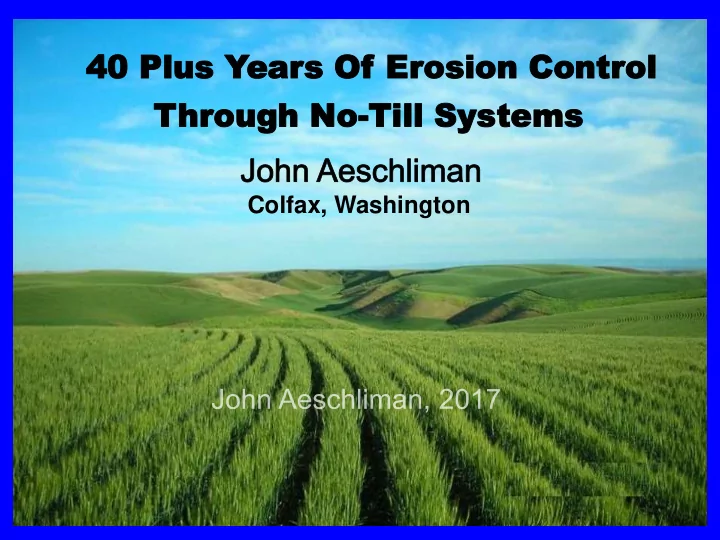

40 Plus 40 Plus Year ears s Of Of Er Erosion osion Contr Control ol Four Decades of Living Proof No-Till Thr hrough No ough No-Till Till Systems Systems Works Under Tough Conditions Colfax, Washington
Home Place Settled in 1880s
Rainfall: • Western end (approx. 15 mi. SW from East end ) 11 – 13 in. • Center Farms 15 – 18 in. • Eastern end (Home Place ) 18 – 20 in. Rotations: • WW SB SW (CF) • WW Garbanzo Beans WW SW • Corn Corn Corn WW WW SW WW • Other Rotations Include Spring and Winter Canola, Sunflowers, Spring and Winter Peas, Quinoa, Various Cover Crops,
Conventional Farming
Tillage Erosion
Tillage Erosion (same field)
Residue, standing corn and wheat stubble
Here is what to do to end the erosion and build soil life.
Direct Seeding on 50% + Slope
Cross Slot Drill Seeding Chem Fallow
What changes have occurred with 40 years of continuous Direct Seeding? 1. Soil wind and water erosion for us is now a non-issue. Rainfall is absorbed and stored for the crop. 2. Residues left on top of the ground control all wind and water erosion. Soil is now alive with microbial communities which feed on the residue. 3. Our natural prairie OM is 1 ½ - 4 ½%. Most OM measurements on the land after decades of no-till is now 3 ½ - 5% and still moving up.
Seeding into stubble
Snow drift and standing residue through the winter, residue helps prevent ditches and erosion
Food Quality is a Function of Soil Quality
Water infiltration and rain simulator
Soil pit and worm castings
Soil clod
We are now with improved and modified Direct Seed equipment able to successfully crop some very sloped fields with no erosion, due to the high amount of residue left in the field and the changes that have occurred in the soil profile due to Direct Seeding.
Direct Seeding Chem Fallow on 50% slope in 18 inch Rainfall
Winter Wheat (same field) in Spring no ditches
Combine and Spring Wheat in 12 inch rainfall
Paired (Twin) Row Wheat with Residue
Cover Crops build soil life and change the rhizosphere to accept and hold inches of extra moisture instead of running off.
Tillage Radish Seeded into Winter Wheat 12 inch rainfall
Radish in Winter Wheat (same field)
Tillage Radish Seeded into Winter Wheat (same field)
Winter Peas into Corn Silage Stubble
Planting into Winter Peas
Winter Peas Dying Down and Corn Growing
Spring Wheat, Corn and Winter Wheat Direct Seeding and No-Till helps infiltration August (18 inch rainfall)
Corn on Winter Wheat Stubble
Sunflowers, Winter Wheat on Sidehill, and Corn In August 18 inch rainfall
Wild life has truly increased due to more feed and cover and less human activity due to no tillage!
Moose and Twins in Wheat
Seeding into CRP Winter Wheat in 11 inch rainfall
Winter Canola seeded into CRP sod 11 inch rainfall
85 bushel winter wheat seeded into CRP 12 inch rainfall
Hard Red Winter Wheat Seeded into CRP (1 st year) 12 inch rainfall
Hard Red Winter Wheat Seeded into CRP (1 st year) in 12 inch rainfall
Winter Wheat and Green Spring Wheat in August 18 inch rainfall
Recommend
More recommend